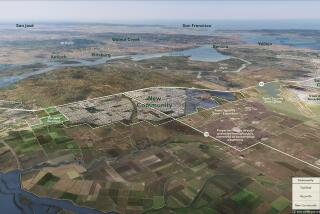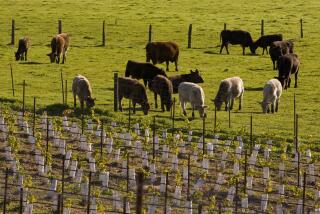Black history at risk?
VISALIA, CALIF. — In 1908, a former slave and retired Army chaplain named Lt. Col. Allen Allensworth realized his life’s dream: a town started and run entirely by African Americans.
Long ago shuttered, the original Allensworth now is a state historic park, cherished by families and church groups who see it as a hardscrabble monument to California’s black history.
But they fear that despite the state’s protection, the settlement named after the charismatic military man is in peril. A 12,000-cow dairy operation is proposed for property just across the tracks, angering park supporters who say foul odors and flies will plague the remote spot and dishonor a noble experiment in self-determination.
“If it weren’t a black historic site, it wouldn’t have to endure these kinds of attacks,” said Victor Carter, a 55-year-old African American accountant from Bakersfield who noted that previous proposals had been fended off -- for a turkey farm and a dump for restaurant grease.
The owner of the 2,000 acres in the vast rolling plain of the San Joaquin Valley, Sam Etchegaray, is a Basque farmer who immigrated to the United States from France in 1963. He and his sons have said in local hearings that, far from dishonoring the legacy of Allensworth, the dairy operation would create 60 jobs and give a $20-million boost to the local economy, ushering impoverished minorities into the middle class.
On Tuesday, before a crowd of more than 100 mostly African American advocates who trooped in from as far as Los Angeles and the Bay Area, Tulare County supervisors voted to put off a decision for at least two weeks to research several technical issues that had been raised by an attorney for a San Francisco-based public-interest law firm.
They made no statement on whether they supported a proposal by state parks officials -- also aired Tuesday -- to negotiate with Etchegaray for his development rights.
In the end, though, some Colonel Allensworth State Historic Park supporters in the crowd were encouraged by supervisors’ reluctance to vote on the spot for yet another dairy operation in a job-hungry, rural area where cows slightly outnumber residents and where more milk is produced than in any other U.S. county.
“I’m more hopeful than when I came through that door this morning,” said Beverly Blake, who drove about 200 miles from Los Angeles.
In the years just after its founding, Allensworth drew more than 300 families, fervent believers in self-reliance who built a hotel, a general store, a school, a church, and a society as formal as any of the day’s urban, middle-class areas. Adults were referred to as Mr., Mrs. or Miss. Some of the colonel’s colleagues kept their military titles, even down to the relatively humdrum “Sergeant.”
Stories still are told about Mrs. Josephine Hackett, an Allensworth mother who would not permit her daughter to go out in public wearing unironed hair ribbons.
Allensworth, who as a slave was sold in retaliation for learning to read, sneaked into a Union encampment during the Civil War and ended up retiring from the Army with the highest rank ever earned by a black man at that point. Along the way, he became a Baptist minister, a lecturer and a visionary who promised to name a planned man-made lake in his new town after his friend, Booker T. Washington.
The lake never came to pass. Allensworth died in an accident in 1914. His town hit hard times when the railroad depot was moved to nearby Alpaugh -- a decision some saw as a racist slap in the face but others attributed to Allensworth’s increasingly dire water shortages. His plan for a California version of Alabama’s Tuskegee Institute also failed to catch on, either in the Legislature or in the black community.
“This town wasn’t completely embraced by the African American community at the time,” said Ken Kramasz, the park ranger who oversees Allensworth. “A lot of people didn’t want to open the door to more segregation.”
In an area that had been alfalfa fields, only three of the town’s original buildings remain. Nineteen have been reconstructed, with architects drawing from plans and photographs of the day.
With white patches of alkali soil showing through the scrub outside, the colonel’s prefabricated frame house reflects his refined sensibilities. A portrait of the young Ludwig van Beethoven hangs near the piano in the parlor, and the mahogany-trimmed walls are painted forest green.
“There was a glee club and a debate society and the first free-circulation library in Tulare County,” Kramasz said. “There was quite a cultured society here.”
Today, visitors trickle in, totaling 1,000 or more during four or five celebrations that are held annually.
“Even with that size crowd, I’ve never seen so much as a beer can thrown on the ground,” Kramasz said. “It’s kind of a spiritual place.” Charles Allen, a 74-year-old retired postal worker, feels that as strongly as anyone. A frequent visitor to the park, he moved from Los Angeles to the present-day Allensworth, an unincorporated, impoverished community next to the park.
“Something was pulling me,” he said. “I couldn’t explain it, but I couldn’t avoid doing it either.”
At the supervisors meeting Tuesday, a group of students from the elementary school in Allensworth stepped to the microphone, one by one, voicing concerns that officials have heard again and again from the dairy’s opponents: The smell, the flies, the increased truck traffic, the possibility of tainted water and the bad air wouldn’t be worth enduring for 60 jobs.
An environmental impact report for the project concluded that the dairy operation spread over the acreage would emit no significant odors and would not draw flies to surrounding areas.
David Albers, an attorney for Etchegaray, told the supervisors that he owns a dairy farm in Fresno County about the size of the operation that his client is proposing. On most of his property, he said, “I don’t smell it. I don’t hear it. It’s simply not a nuisance.”
Speaking for the Tulare County Farm Bureau, Brian Blain said modern equipment and pest-control methods have improved the neighborliness of large dairies: “We have one less than a mile from my house and it’s a very rare occasion -- maybe a few days a year -- that there’s anything to indicate a dairy anywhere nearby.”
But there were many skeptics in the crowd.
“People are not stupid,” fumed Acquanetta Warren, a Fontana City Council member and a state parks commissioner. “I just can’t believe this.”
In an interview, Warren said she would “insist” that the state file suit if the dairy were approved.
But an attorney for the state Parks and Recreation Department raised the prospect of a compromise. Approve the dairy if you want, Kathryn Tobias told the supervisors, but at the same time, allow the state to bargain with the landowner for his development rights.
Tobias said later that officials did not have a price in mind, but that funds from recently passed Proposition 84 might be available.
Neither Etchegaray nor his family members spoke at the hearing. But Albers said his client was interested in exploring the idea.
As the board decided to delay its decision, Supervisor Steve Worthley expressed his frustration, pointing to a stack of environmental reports 6 inches thick. He said it would be necessary to research three “11th hour” issues raised that day by Avinash Kar, an attorney for the Center on Race, Poverty and the Environment.
Kar said the impact report had not addressed the environmental harm of antibiotics fed to cattle, a subject raised in a government report last month. He also pointed to research concluding that big dairies are economic burdens to nearby communities and alleged that the impact report had failed to consider the Allensworth area.
If the supervisors decide in two weeks that no further study of those issues is required, officials said, they will be free to vote on the dairy with no further public comment.
*
More to Read
Sign up for Essential California
The most important California stories and recommendations in your inbox every morning.
You may occasionally receive promotional content from the Los Angeles Times.










